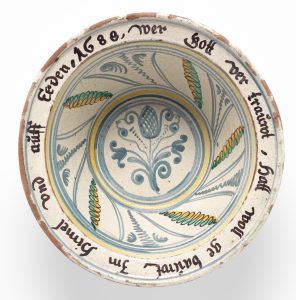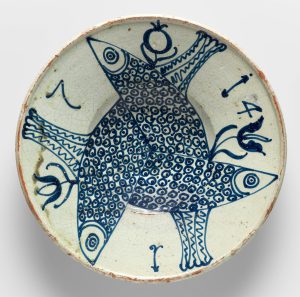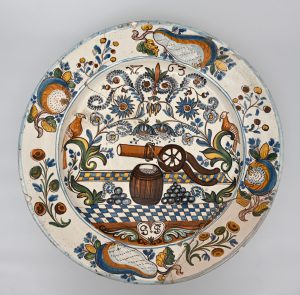



Underglaze brushwork decoration, Winterthur, Bernese midlands, Blankenburg, Bäriswil.
Underglaze brushwork decoration in CERAMICA CH
This is a distinctly Swiss type of decoration that is found on earthenware vessels. In the German-speaking part of Switzerland, the decoration was created by using a brush to paint blue, red or polychrome patterns onto a coat of white slip, which was then lead-glazed (hence the term underglaze brushwork). It was a cheap way of imitating faience because it did not require the considerably more expensive lead-tin glaze (with in-glaze painted decoration). The actual glaze used to coat the vessels was usually colourless or a pale green to yellow; in archaeological finds, the glaze is often severely weathered or almost completely degraded. Underglaze brushwork decoration was popular in Switzerland from the late 17th to the 19th century. The main places of production included Bäriswil, Blankenburg, St Antönien and Winterthur, but it was also manufactured in the Bernese midlands and in other areas throughout the German-speaking part of Switzerland (and perhaps Graubünden). It is not always possible to distinguish between underglaze brushwork decoration and very thin slip-trailed decoration.
Underglaze brushwork decoration on a coat of white slip is also known from other regions outside of Switzerland, for instance blue and white “Arnstadt faience”, blue and white pottery from Diessen on Lake Ammer (Bavaria) and blue and white or polychrome decorations from southern Lower Saxony/northern Hessen (Oberode).
From a technological point of view, cobalt blue and manganese purple decoration under salt glaze on stoneware or cobalt blue brushwork decoration on porcelain could also be termed “underglaze brushwork decoration”. In a bid to make a distinction between these and the earthenware vessels described above, however, they are usually referred to just as brushwork decoration. Brushwork decoration under the glaze is also found on refined white earthenware (painted directly onto the biscuit-fired body and then glazed), where it is sometimes used to add coloured details to transfer-printed decoration. In the context of CERAMICA CH, this too is referred to simply as brushwork decoration. Further distinctions are then also made between brushwork decoration under the glaze, brushwork decoration on the glaze (overglaze painted decoration) and brushwork decoration in the glaze (in-glaze painted decoration).
In the context of late 19th and 20th century production, we only distinguish between brushwork decoration, overglaze painted decoration and in-glaze painted decoration.
Translation Sandy Haemmerle
German: Unterglasur-Pinseldekor
French: décor au pinceau sous la glaçure, décor peint sous glaçure

